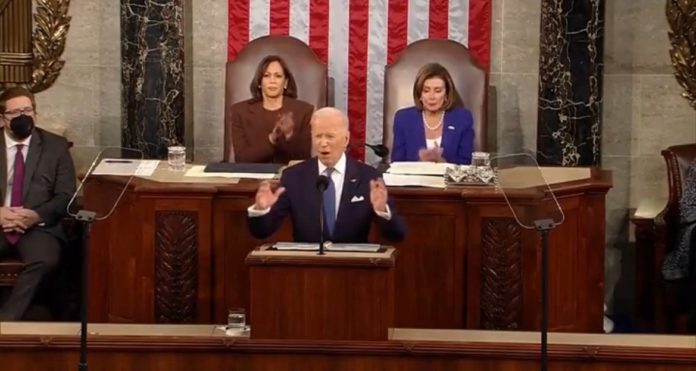If President Joe Biden was hoping to get a significant bounce out of his State of the Union address Tuesday, he failed miserably.
The Civiqs daily tracking poll shows just 35 percent approve of his job performance as of Thursday, two days after the big speech.
Similarly in the Rasmussen daily tracking poll, Biden actually saw a mini-bump from 41 percent Tuesday to 44 percent on Thursday.
However, by Friday, his approval rating was already back down to 42 percent.
One NPR/PBS NewsHour/Marist poll did find the president’s approval rating jump 8 percentage points from last month’s 39 percent to 47 percent after his State of the Union message, but it seems to be an outlier.
NPR attributed the improvement in their poll to a “rally-around-the-Ukrainian-flag moment” for the commander-in-chief.
The Real Clear Politics average of polls still finds Biden nearly 12 percentage points underwater with just 41.6 percent approving and 53.5 percent disapproving, which is around where he has been for months.
The takeaway is that the 46th president remains unpopular because he didn’t announce any policy changes that would have improved his standing with the American people.
There was no change in his clampdown on oil exploration in the United States, even as the nation continues to import large quantities of oil from Russia, despite its invasion of Ukraine.
During his State of the Union address, Biden said that he would be releasing 30 million barrels from our own Strategic Petroleum Reserve.
But that is literally a drop in the proverbial bucket.
The U.S. consumes between 18-20 million barrels a day, so the release Biden is planning would only provide less than two days’ supply.
The price of oil actually went up following Biden’s announcement, to $115 a barrel. During the same week last year it was $61.
Gasoline is up over dollar a gallon from last year.
What Biden needed to do was change course.
In the early days of Biden’s presidency, he signed executive orders under the auspices of addressing climate change that included suspending oil and gas exploration leasing on federal lands and reinstating an Obama-era carbon dioxide emission federal fee to oil-drilling operations, which had been lowered significantly under Trump.
Additionally, the Biden administration shut down oil exploration in the Arctic Wildlife Preserve and canceled the Keystone XL pipeline from Canada.
Last week, Biden’s team announced it would be delaying decisions on new oil and gas leases and permits on federal lands after a judge ruled officials had no constitutional authority to impose higher climate fees on drilling without congressional approval, CNBC reported.
Another major course correction Biden did not make was away from big-government inflationary policies.
NPR/PBS NewsHour/Marist Poll released late last month found just 39 percent thought his first year was a success.
The top issue respondents listed as problematic was inflation.
The same was true in an ABC News/Washington Post poll conducted during the late February time frame.
In that survey, just 30 percent of independents approved of Biden’s job performance.
In his State of the Union speech, the president offered no plan on how he would address inflation.
In fact, he called for new government spending, when the nation has a $2.77 trillion deficit in 2021, much of that caused by the $1.9 trillion American Rescue Plan passed in March of last year.
A final major change Biden needed to make but didn’t was in relation to COVID-19 policies.
With cases, hospitalizations and deaths way down to levels not seen since last summer, it’s time for mask and vaccination mandates to end.
With two-thirds of the population vaccinated and much of the rest likely naturally immune from having already recovered from the virus, the time for mandates has long since passed.
The Centers for Disease Control and Prevention estimates 43 percent of the population has antibodies from the virus.
Biden had a chance to pivot on key issues impacting Americans’ daily lives during his State of the Union address, but he didn’t.
Unsurprisingly, his job approval numbers remain in the tank.
This article appeared originally on The Western Journal.


